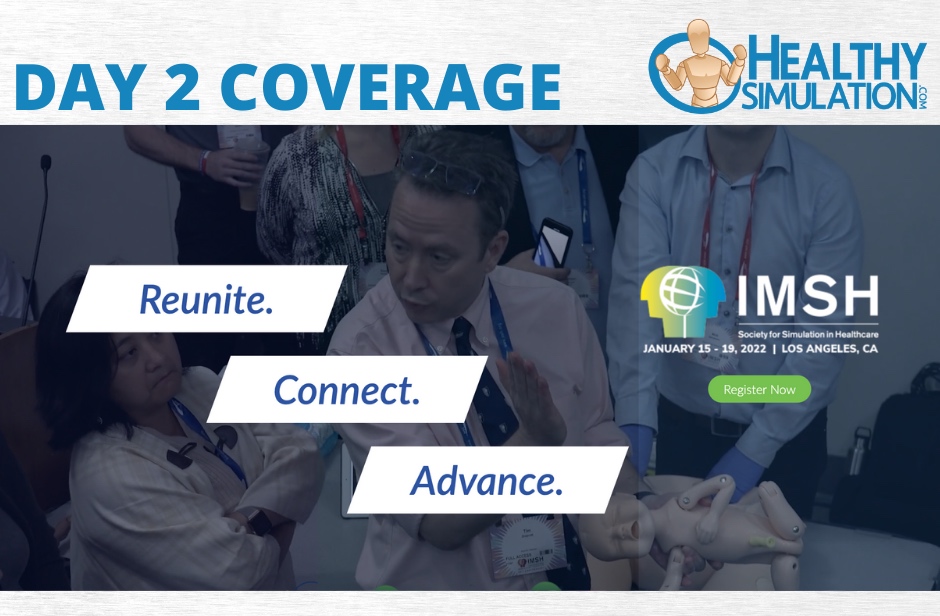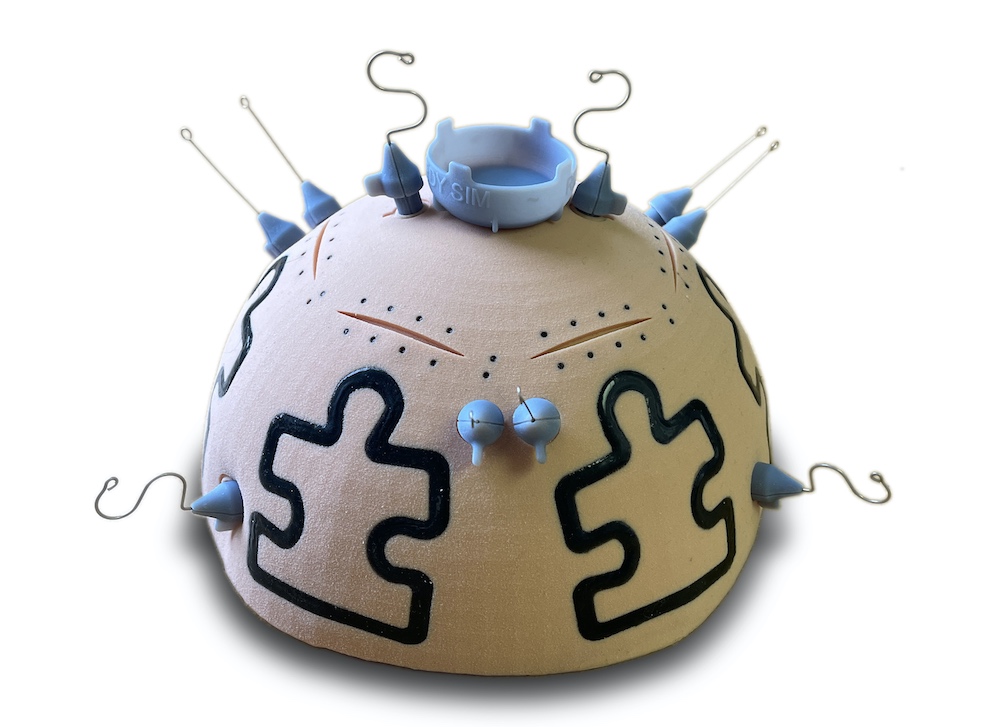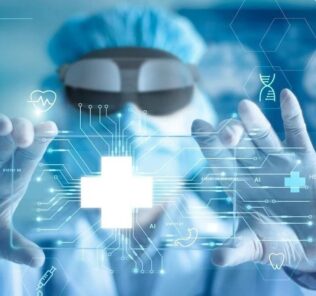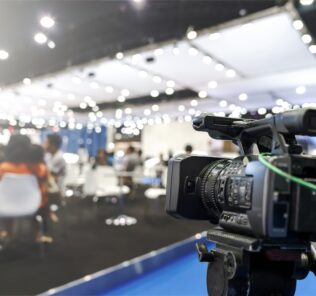IMSH 2022: Day 2 Healthcare Simulation Conference Information, Updates
The 2022 International Meeting for Simulation in Healthcare (IMSH) is here! Hosted by the Society for Simulation in Healthcare (SSiH), this year’s event provides an opportunity for healthcare simulation champions from around the world to come together. IMSH 2022 remains a hybrid event as planned, taking place in person and virtually from January 15 to January 19, 2022, in Los Angeles, California at the Los Angeles Convention Center. This year, SSH welcomes more than 90 exhibitors and more than 1,200 registered simulationists! Today’s events include The Lou Oberndorf Lecture on Innovation and Healthcare Simulation, group meetings, CHSE/CHSOS testing, educational sessions, and more.
IMSH 2022 Monday Plenary Session
The Lou Oberndorf Lecture on Innovation and Healthcare Simulation presents “Erica Dhawan: Get Big Things Done. The Power of Connectional Intelligence” on Monday, January 17 from 8:30 AM to 9:45 AM. Erica Dhawan is an internationally recognized leading authority, speaker, and advisor on 21st-century teamwork, collaboration, and innovation. Named by Thinkers50 as the “Oprah of Management Thinkers”, she is the author of two books Get Big Things Done: The Power of Connectional Intelligence and Digital Body Language: How to Build Trust and Connection, No Matter the Distance. Dhawan speaks on global stages ranging from the World Economic Forum at Davos to TEDx and for companies such as Coca-Cola, FedEx, Goldman Sachs, Walmart, SAP, and Cisco. She has degrees from Harvard University, MIT Sloan, and The Wharton School.
Sponsored Content:
HealthySimulation.com & SSH Press Box Partnership
All this week in the vendor hall, SSH and HealthySimulation.com are working together to promote discussions important to the global industry. Those in person can listen in, and those unable to attend will be able to watch the recordings of this content soon! Talks include:
- Day 1 (Sunday, 4-6 PM) – REUNITE:
- 4:00PM – 4:45PM: Survey Results: “Impacts of COVID on Healthcare Simulation”
- 4:45PM – 5:15PM: Impacts of COVID Vendor Panel featuring EMS & CAE Healthcare
- 5:15PM – 5:45PM: More updates coming soon!
- 5:45PM – 6:00PM: HealthySim LEARN Platform Update
- Day 2 (Monday, 11:30-1 PM) – CONNECT:
- 11:30AM – 12:00PM: Shared Stories: Successes in Simulation
- 12:00PM – 12:30PM: SSH President’s Interview
- 12:30PM – 1:00PM: SSH Accreditation & Certification
- Day 3 (Tuesday, 11:30-1 PM) – ADVANCE:
- 11:30AM – 12:00PM: The Metaverse is Calling, How XR Will Change Simulation
- 12:00PM – 12:30PM: Advancing the Industry, What We Need to Achieve Mass Adoption
- 12:30PM – 1:00PM: More Updates Coming Soon!
Stop by the Press Box in the back of the vendor hall for more!
Daily Program Schedule
All times Eastern Time Zone (United States)
Sponsored Content:
Monday, January 17, 2022
7:00 AM – 8:15 AM: Section, Interest Group, and Affinity Group Meetings
7:00 AM – 4:30 PM: Registration
7:00 AM – 4:30 PM: SSH Central
7:00 AM – 4:30 PM: Presenter Center
8:30 AM – 9:45 AM: Plenary Session: The Lou Oberndorf Lecture on Innovation and Healthcare Simulation presents “Erica Dhawan: Get Big Things Done. The Power of Connectional Intelligence”
9:30 AM – 4:00 PM: Exhibit Hall Open
10:00 AM – CHSE/CHSOS Testing
10:00 AM – 11:30 AM: Educational Sessions
10:00 AM – 11:30 AM: SSH Technology Experiential Area
11:30 AM – 1:30PM: Lunch in Exhibit Hall
12:15 PM – 1:15 PM: Committees, Section, and Affinity Group Meetings
1:30 PM – 2:30 PM: Educational Sessions
1:30 PM – 2:30 PM: SSH Technology Experiential Area
2:00 PM – CHSE/CHSOS Testing
3:00 PM – 4:30 PM: Educational Sessions
3:00 PM – 4:30 PM: SSH Technology Experiential Area
6:00 PM – 10:00 PM: Industry Sponsored Events
Session Recap
(Elizabeth Wells-Beede, Ph.D., RN, C-EFM, CNE, CHSE-A, shares her experience from the presentation sessions of IMSH Day 2)
Check back for the daily recap!
Key Note & Awards
The morning began with the Presidential citations where Dr. Maxworthy presented heartfelt awards to two people that have been instrumental in her growth and leadership. First, her father whose service to the community was instrumental during the pandemic in providing fresh food and resources to food banks. Second, was Dr. Bob Armstrong, former president of SSiH. Additionally, Dr. Maxworthy presented the inaugural Pioneering Award for Simulationists to Dr. Debra Spunt. Dr. Pam Jeffries and Dr. Mary Ann Rizzolo accepted the award on behalf of Dr. Spunt. Their beautiful account of Dr. Spunt and her legacy was apparent in why she was chosen for this inaugural award.
In the morning, the keynote Dr. Lou Oberndorf lecturer was Erica Dhawan. This lecturer may possibly have provided paramount resources and ideas to help leaders with the idea of the digital shift that is occurring now due to the global pandemic. She asked, “How will we create a BETTER normal?”
As innovators in the industry, it is our moment to begin taking the lead in what Dhawan describes as Connectional Intelligence. It is important to take these opportunities placed in front of us now and begin to design new ways of generating ideas through innovation and collaboration. It was a reminder to all the attendees during trying times that much of what we do in healthcare simulation can be translated once again to our everyday interactions with our peers, learners, and community of interest.
There were also a number of points to her discussion that rang similar to the Basic Assumption and how we can learn to “trust-totally” during trying times. Dhawan shared a toolkit to learn more and practice digital body language. A toolkit was shared with those present at the keynote and is available by texting Dhawan to 66866.
Morning Session:
Case Study: Three Schools of Nursing begin the journey of assessing and evaluating competence through the curriculum with presenters from three institutions of higher education in undergraduate nursing programs conducted a panel discussion with Q&A from the moderator. This case study discussed their experience in developing a model for evaluation utilizing the sim capture and incorporating different modalities of evaluation for educators, facilitators, and learners. Some of the tools discussed that are validated include the Creighton Tool and DASH.
Each spoke to the significance of adequately utilizing the data longitudinally for a demonstration of “competency” with both the learner and the facilitators within the simulation. How the tools can be incorporated to help with professional development and remediation. The presentation has provided lessons learned and identified gaps in the process that are instrumental with the ongoing development and seeing inter-rater reliability and some of the technology concerns. This will be a journey to follow to gain further insight as nursing moves toward competency in hopes of providing clarification of what is expected with what they define as competency.
Afternoon Sessions:
Augmented Reality Training: Education to Save Maternal-Child Lives
A study exploring the utilization of an augmented reality simulation was conducted with undergraduate nursing students with the CAE LucinaAR (CAE Healthcare, n.d.) during the Maternal-Child rotations with over 121 students. The AR simulation was delivery and postpartum hemorrhage. As with many programs, some learners may or may not have had theory prior to the simulation, so the presenters worked to help mitigate any problems that may occur. This particular study identifies some much-needed data to help facilitators navigate side effects that could occur with using AR/VR technology.
General discomfort, eye strain, and some dizziness were the most common responses. The tool utilized was the VRSQ which is currently a tool under its own analysis by the authors. As we continue to navigate where the future will be in AR/VR technology within healthcare measurement tools and assess whether the learners are gaining a reciprocal experience as they would with a high-fidelity simulation. The presenters also shared their experience with debriefing the simulation and expressed concern regarding the inability to “see” what the learner is viewing in time and space. This was a limitation that would benefit from further investigation.
It was refreshing for them to share their experiences and the “oops’ ‘ moments to help those that may want to explore the virtual environment. You can explore more about this study and stay tuned for their future publications. Q&A was limited, indicating that this area is growing and the research coming out with this upcoming new technology is going to be needed.
Final Session (3 PM)
The final session for Day 2 was a look at mastery learning through deliberate practice. The presenters went through their definition based on the interpretation from studies conducted regarding mastery learning. As their definition, they described what is considered the best standard of practice that is necessary to meet safe patient goals. They provided several active learning modalities to help the audience gain insight into what they believe to be deliberate practice.
Both Drs. Barsuk and Salzman have been working together for over a decade and it was noticeable during the presentation. It was apparent they practice what they preach per se and their expertise in the content was shared throughout their presentation. The discussion with the audience was engaging throughout and with the number of attendees, both the first time and the second time, it was evident that they felt comfortable sharing their knowledge on the mastery model of education.
This particular topic has been one of interest for some time and is important for practitioners at all levels regardless of their own expertise due not only to the fact that healthcare is iterative and changing at a speed that leaves practitioners at a loss to keep up, but also stagnation of skill requisition. They pointed out on several instances the significance and importance of continued practice and ongoing mastery through deliberate practice to ensure safe patient outcomes. In addition, they provided how important the feedback is for this model of teaching, which is similar to coaching with formative feedback throughout and at appropriate times.
Vendor Updates
1) Remedy Simulation released the company’s first FRS Dome (Fundamental Robotic Surgery). This was developed and produced in partnership with a non-profit institution to provide devices for neurological robotic surgery training. Training exercise diagrams are cast into the silicone outer skin, and multiple tissue layers offer an authentic feel and surgical experience. Further, incorporated vessels provide a more realistic training scenario, and 3D printed inserts with wire connectors challenge trainees’ dexterity.
FRS is a multi-specialty, proficiency-based curriculum of basic technical skills to train and assess surgeons to safely and efficiently perform robotic-assisted surgery. It was developed by over 80 national/international robotic surgery experts, behavioral psychologists, medical educators, statisticians, and psychometricians. The clinical robotic surgery subject matter experts represented all of the major surgical specialties in the United States that currently perform robotic-assisted surgical procedures, the Department of Defense and the Veterans Administration (VA).
The goals and objectives of the basic skills and tasks for robotic surgery are to train and assess the proficiency of the psychomotor robotic skills of the surgeon. This will ensure that only the surgeons who are skilled and well trained in robotic surgery perform such complex procedures, making the patient the ultimate benefactor. The FRS Dome is ultimately designed for seven tasks:
Task 1: Docking and Instrument Insertion Subjects will realize the docking task introducing the trocars for the camera and instruments into in the white-box trainer. The dome will be in the closed box.
Task 2: Ring Tower Transfer Four towers with an S-wire are positioned on the dome, two towers on the center cap and two on the lower part (one on the left side and one on the right side). There is an 8 mm ring on the base of each tower located at the upper part of the dome. Using both hands, subjects will transfer the ring from the S-tower on the cap to the S-tower on the skin surface, twice.
Task 3: Knot Tying Subjects will tie a surgeon’s knot to approximate the two eyelets of the “I” towers such that they touch each other and back up the knot with a square knot (two throws).
Task 4: Railroad Task Horizontal mattress suture will be made through the target points to approximate the tissue.
Task 5: 4th Arm Cutting Subjects will pick up and stretch the elastic band with the first and third arms and use a second arm instrument to cut at the marks. Place the cut sections in the bowl on top.
Task 6: Puzzle Piece Dissection – Subjects will cut out and dissect the shape marked on the skin.
Task 7: Vessel Dissection Subjects will dissect through the fat layer to expose the vessel, cauterize and cut the vessel.
2) Ingmar Medical invites IMSH 2022 attendees to visit the company at Booth #707. Here are 3 reasons to stop by:
- Add the company’s Learning Lab, “Scenario Building 1o1 with RespiSim,” to your schedule on Monday, 1/17 @ 4:30 PM EST. This free session can be beneficial for RespiSim users as well as any educator interested in scenario-building strategy. Walk away with the confidence and resources to build your own scenarios from scratch!
- See the brand NEW RespiPro in action! Watch live patient-ventilator interactions with this all-in-one respiratory simulation solution.
- Chat with friendly Product Specialists and RTs and pick up some cool swag
3) Strategic Operations will be exhibiting and holding hyper-realistic trauma surgery simulations using the company’s Cut Suit at the IMSH 2022. The Cut Suit is the only open surgery simulator that is Hyper-Realistic, repairable, and thus cost-effective, the subject of numerous peer-reviewed scientific papers, and is part of curricula for both medical students and surgeons. The surgical Cut Suit has been used by military and civilian surgeons, emergency room doctors, and other medical providers extensively over the last few years. Designed by surgeons, for surgeons, to teach surgeons, Advanced Surgical Skills Packages (ASSPs) allow Hyper-Realistic simulated surgical procedures that replicate various trauma and pathology scenarios. The ASSPs are rented, shipped in pre-paid returnable containers, repaired at STOPS, and placed back into rental inventory, effectively becoming Medical Simulation as a Service (MSaaS).
Daily Event Coverage
More About IMSH
The Society for Simulation in Healthcare (SSH) hosts IMSH annually and offers over 250 sessions encompassing interactive and immersive courses and plenary sessions. The IMSH meeting is aligned with the SSH’s mission to “provide hands-on learning in leading-edge medical simulation trends and technology, networking and collaboration.” Furthermore, the programs are all peer-reviewed and are selected to serve the needs of novices to experts.
“Every year, professionals from all experience levels and from more than 50 countries attend IMSH,” Kathy Adams, Director of Continuing Education, SSH, said. “Any professional interested in or currently working in healthcare simulation will find value in the healthcare simulation conference; the range of learning formats — from small, interactive workshops, to large, inspiring plenaries – and the breadth of topics presented by global experts ensures that there is something for every learning style, interest and experience level.”
At IMSH meetings, key areas of discussion are often new ideas, leadership development, new processes, and research findings, innovative approaches, design strategies, return on investment, and improved communication techniques. As a catalyst for advancement and evolution in healthcare simulation technology, the IMSH brings together and connects industry professionals to learn. The event is considered to be one of the top educational and networking events for the healthcare simulation world, especially for those with interests in IPE.
Learn More About IMSH 2022
Lance Baily, BA, EMT-B, is the Founder / CEO of HealthySimulation.com, which he started in 2010 while serving as the Director of the Nevada System of Higher Education’s Clinical Simulation Center of Las Vegas. Lance also founded SimGHOSTS.org, the world’s only non-profit organization dedicated to supporting professionals operating healthcare simulation technologies. His co-edited Book: “Comprehensive Healthcare Simulation: Operations, Technology, and Innovative Practice” is cited as a key source for professional certification in the industry. Lance’s background also includes serving as a Simulation Technology Specialist for the LA Community College District, EMS fire fighting, Hollywood movie production, rescue diving, and global travel. He and his wife live with their two brilliant daughters and one crazy dachshund in Las Vegas, Nevada.
Sponsored Content:



















